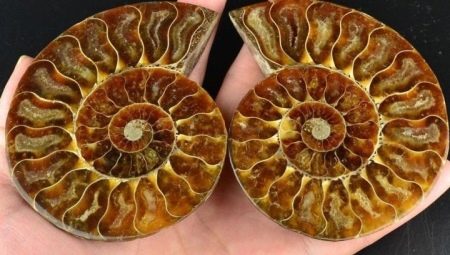Ammonite is an interesting stone that can interest everyone who likes to observe the creations of nature and study them, collect them. The mineral itself once served as a shell-house for giant mollusks. They existed on Earth in the era of dinosaurs, moreover, they appeared before these living creatures. The mineral became a fossil about 200 million years ago.
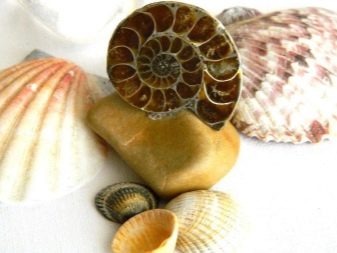
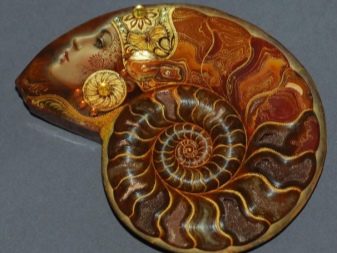
Description
Interest in ammonite is also noted by lovers of rare stones, and by scientists. This is really an interesting natural creation that looks like a work of art. It is impossible to find two identical shells: the analogy with snowflakes and fingerprints of human hands is not accidental. If you have ammonite in your collection, you can be sure that no one else has exactly the same.
All fossil specimens are related only by a bizarre spiral shape resembling a spring from a watch, a ram’s horn or even a paper clip. Each sink inside consists of departments (chambers), and those, in turn, are separated by partitions. The smallest is located at the base, the closer the exit, the larger the size of the partitions.
It is all the more interesting to suppose how a mollusk, characterized by soft body, coexisted with such a complex shell.
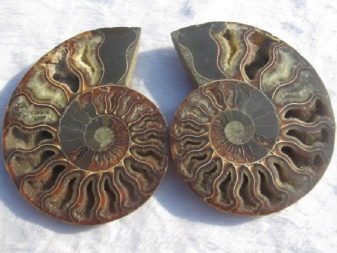
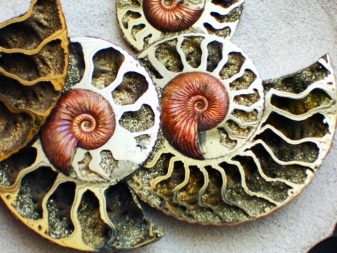
Varieties
The age of ammonite is 200 million years. For such a venerable period, the mineral changed, which led to a considerable number of types of stone. On average, ammonite is a smooth, pleasant to the touch surface coated with nacre. On this mother of pearl - different shades of grooves that do not repeat. You can find ammonite of any size: from very small to huge.
The color depends on the color of the mineral trapped in the stone chamber. Usually the leaders are blue, green, orange and yellow shades, which have calcite and chalcedony inside. If pyrite is "cluttered" into the chambers, the surface of the ammonite will sparkle like gold. It is considered good luck to find a rare combination of minerals: there are samples that belong to the calcite group. If ammonite is filled with symbircyte, then it can be confused with amber and carnelian. The thing is the same pyrite, which gives the mineral a yellow-red color.

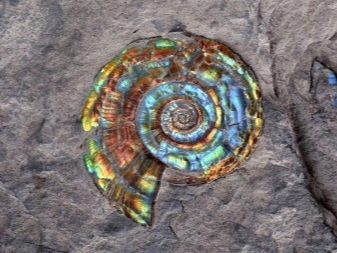
Often confusion arises between ammonite and ammolyte, the latter being a type of ammonite. To obtain it, special conditions and a lot of time are needed. So, it is correct to call ammolith stone, formed as a result of the mineralization of ammonite shells in the composition of rocks. But what unites absolutely all varieties of ammonite is the pearl coating. It will be present in both the inside and the outside of the stone.
And no matter how many years he spent underground.
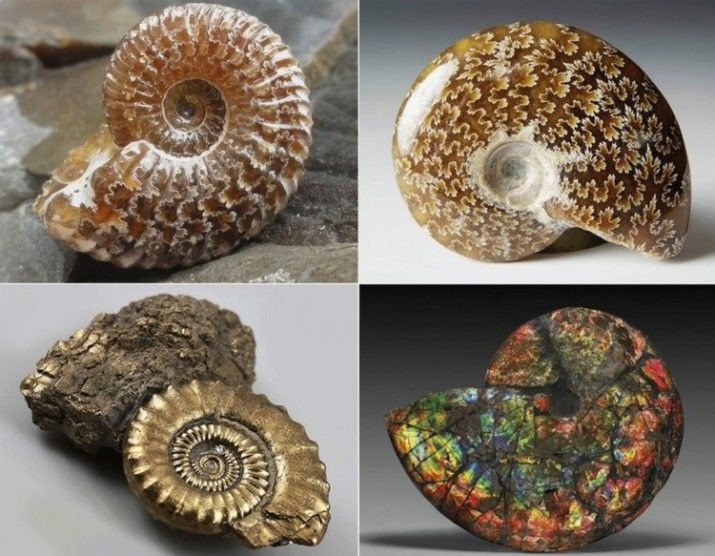
History
At the end of the 18th century, the French explorer J. Brugier gave the stone the name by which it is now known. But the origin of the stone, its magical properties, wonderful stories associated with it - this is a whole layer of information, speculation, scientific and historical assumptions making the study of stone even more fun.
- In ancient Egypt, the god Amon was worshiped, who was considered the patron saint of the universe. He looked like a ram with characteristic twisted horns. And these horns, which were spiral curls, were considered something divine. The Romans picked up this legend in the sense that the stone, known to us today as ammonite, was called the horn of Amon.
- In Ireland to this day, this stone is sometimes called a petrified snake. And all because of a long-standing legend that speaks of the abbess of the monastery, who managed to save the village from the attack of snakes. She turned reptiles into stones, which earned her being counted as a saint. Many residents take the legend seriously, because even stone-cutters sometimes show fossils with snake heads.
- In Germany, the one he found ammonite, considered him a golden snail. It was also a very good omen, as if with a stone you were gaining happiness, luck, a new life.
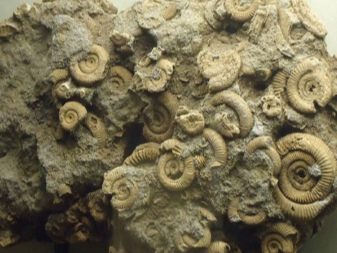
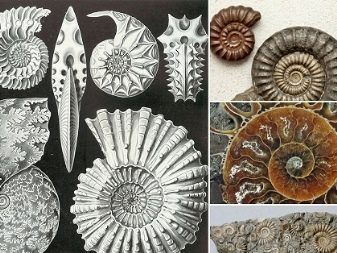
Paleontologists can stay in ammonite deposits for a long time. They consider this stone an amazing subject of study. To date, the number of varieties of stone is about 3,000.
Application
Why is ammonite not a choice for the mass consumer? Yes, it does not look like sapphire or diamond, but it is not a stone of the luxury collection. If you liked this amazing artifact, then you are probably interested in delving into history, and you are delighted with the fact that you have something from prehistoric times in your hands. Just think: ammonite found dinosaurs and tree plants. Yes, and the sink itself seems to be an elegant work of art, I can’t believe that this is a natural cut, that the shell was not made by a person.
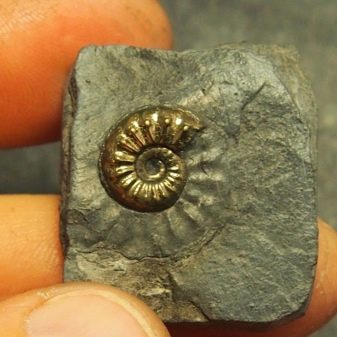
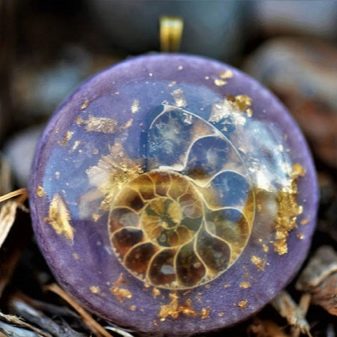
Organic stones are well suited for making pendants, brooches, beads, earrings, rings. The shells themselves are colorful, picturesque. Usually, gifts with such a stone are appreciated by artists and creative people.
They are fascinated by this unique natural design, and they know how to decorate themselves with such a curiosity.
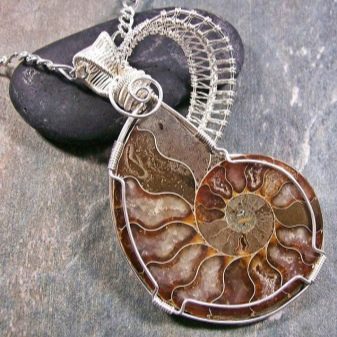
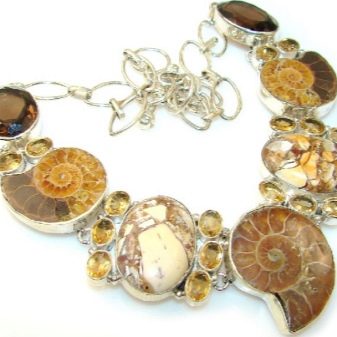
If the specimen is large, then it is usually sawn, then polished, cleaned of impurities and clay. This is done so that the mother-of-pearl essence of ammonite is brought to the world. Such beautiful pieces of sawn stone are decorated not only with jewelry, but also with coffee tables, fireplaces, watches, aquariums. If you are a novice collector, collecting minerals from all over the earth, attractive ammonite should definitely appear in your collection.
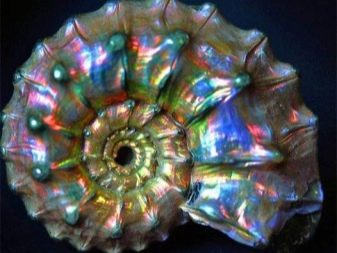

Stone magic
A spiral, a shell of stone is a symbol of eternity, common in many cultures.In the Indians, these shells were used for special magical rituals. For example, if rainfall became a vital necessity, then they could have caused it just with the help of ammonite, which, however, they called the "stone of buffalo." Using a shell, they found the source of the river. Be sure to take the stone with him and to hunt - it was believed that it brings good luck and protects against risks. Even today, some hunters are given ammonites. Here are some other magical properties attributed to the stone in antiquity.
- Longevity. It was believed that one who honors this stone and wears it will live a long time.
- Clairvoyance. It was also believed that stone can develop the beginnings of clairvoyance in man.
- Communication with the subtle world. The stone supposedly allowed people to carry out spiritualistic sessions.
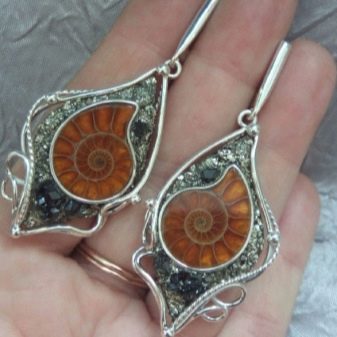

If you make an amulet from a mineral, it can become a very powerful talisman. The symbolic meaning of ammonite is luck, the attraction of wealth, peace in the family. And they say that ammonites are healing stones. But whether it can be healing depends on the mineral found in ammonite. Since the chemical composition of the fossil is strictly natural, such mining can really affect the human condition.
Lithotherapists assure: the fossil can help in the treatment of blood diseases, it can cure skin ailments, increase immunity, and give new protection against stress. They say that if you keep ammonite in the bedroom, it can help in the fight against insomnia.. And the stone can help with reproductive problems. Shamans and sorcerers believed that the fossil creates special vibrations - they seem to reboot the body, make it work in a new way.
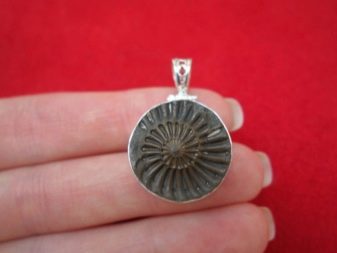

Chinese practices
Chinese physicians, or rather, those specialists whom we could call representatives of alternative medicine, have a special attitude to ammonites. They believe that the stone will allow to establish the internal "upset" human energy. It is known that many in China resort to treatment with applicators and massage, and biological minerals in this sense are used very widely.
Chinese doctors believe that massage with applications of ammonites can set internal systems to the correct mode of operation, can normalize blood flow. It is interesting that all the massage movements that the specialist makes repeat the curls of this biological formation on the human body. What is it for? To create a vortex of internal body fluxes. The energy swirling and renewed by displacement returns to its original position, which leads to balance.
Doctors believe that the failure that led to the disease goes away.
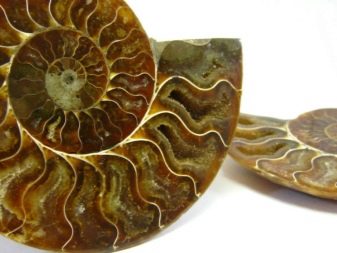
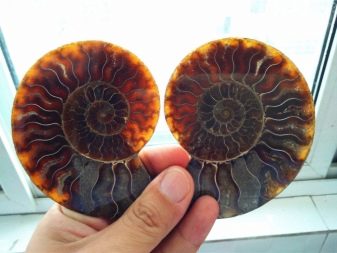
If we draw a parallel with the opinion of many healers that any internal (spiritual) imperfection leads to illness, then massage can also restore this constancy, calmness, even energy. As a result, the ailment goes away. Representatives of evidence-based medicine often advise their patients with psoriasis and skin diseases to wear jewelry with ammonite. There is an opinion that the stone helps to overcome scarlet fever and measles.

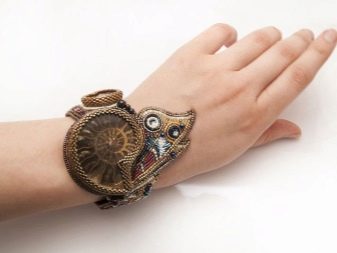
About fakes and real stones
There are no strict prohibitions on the wearing of ammonite: it cannot harm anyone. But still, Libra, Aquarius, Cancer, Scorpio and Fish, the fossil is more suitable. Capricorn should wear this shell if it is filled with chalcedony. All significant characteristics remain only with real ammonite. But worrying about whether or not you have a fake is not worth it. Oddly enough, artificial stones will cost more - a lot of strength will be required to repeat what nature intended.
Fossils themselves are inexpensive, because it makes no sense to pass off a synthetic product as natural. Other outlandish shells are found by seekers throughout the Earth. An amazing mineral formation called ammonite is found only at one point on the planet in the province of Alberta, which is located in Canada.
Similar relict shells were found in Adygea, huge fossils were found in Bavaria.
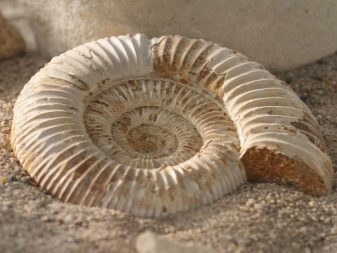
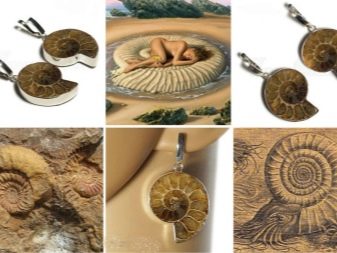
Who is it for?
It is believed that blue (and other types of stone, too) ammonite is perfect for people whose work is related to water. It can be plumbers, swimmers, divers, aquarists, land reclamators, divers. If you intend to take a water trip, ammonite can become a faithful amulet.
There are cases when psychotherapists who worked with patients who are afraid of water involved ammonite in therapy. The stone was first used indirectly - it could just lie on the table, etc. Then it served as a guide, which supposedly guaranteed a person that protects him from disasters associated with water.
If you are calm about luxury jewelry, but all the interesting, prehistoric fossils, minerals make you tremble, you will like ammonite.
He will decorate the collection, become a highlight in the interior decor or will find its place in underwear.
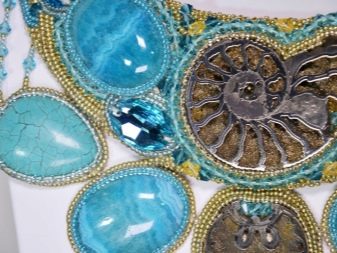

A review of ammonites in jewelry is in the next video.
